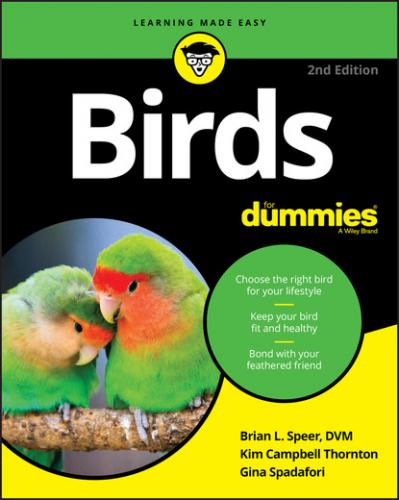Keeping Your Bird Entertained
Toys, like the ones shown in Figure 4-3, are not optional when it comes to pet birds. A constant variety of interesting and destructible toys is essential to your bird’s mental and physical well-being. They give your bird something to do with both his mind and his body, keeping him fit and staving off boredom. A bored bird is at high risk for behavioral and health problems, such as feather picking.
Photograph by Kim Campbell Thornton
FIGURE 4-3: Good bird stores, pet stores, and online retailers carry every kind of toy your bird could possibly want or need.
Providing play and opportunities to perform natural behaviors such as foraging for food are an essential part of living with a bird. You may have heard it called enrichment, a term that encompasses puzzle toys; destructible toys; multiple perching sites; stainless-steel baffle cages filled with treats, fruit, veggies, toys, or shredding material; and play areas with climbing and swinging objects, to name just a few of the ways we can benefit birds by addressing their mental health needs.
Different types of toys serve different functions. Some toys entertain, some are brain games, some let birds practice their amazing manipulation skills, and some are just for tearing apart. Anyone with a young child — or who remembers being one — knows how much fun that is.
Play stands and gyms
Most pet birds — from budgies on up in size — need time out of their cages to explore, exercise, and socialize (the exceptions are canaries and other finches, who are happy to be left alone in roomy cages). You could allow your birds to explore, taste, chew, and destroy your furniture, or you could offer them an alternative — a play stand, gym, or other safe location (see Figure 4-4).
Photograph courtesy of Rachel Baden, DVM
FIGURE 4-4: A rose-breasted cockatoo has an assortment of toys on the play stand that tops her cage.
Play stands come in two varieties, for the most part: large, freestanding models or those designed to rest on a table. The freestanding models are fit for the largest parrots.
Any size stand or gym offers a variety of perches, swings, and ladders; places to attach toys; and usually a container for food and water. They can be made of natural material (such as grapevine or wood branches) or of turned-pine dowels or hard plastics. A skirt or tray incorporated into the design helps capture mess and thrown food.
Food as entertainment
Don’t underestimate food as a way to keep your bird busy and amused. Check out puzzle toys designed to make eating a challenge. These challenging toys have skewers or nooks to hold foods such as fruits or nuts and are meant to make a game out of getting to these treats. One of our particular favorites is an acrylic tube you load up with favorite items, with holes to insert plain wooden pegs. To get the treats or toys out, the bird has to figure out how to pull the plugs. Ingenious!
Puzzle toys vary in complexity and may require birds to unscrew the toy, find food hidden in pockets or other compartments, lift flaps, or shake food out. Depending on the level of difficulty, you may have to help him learn how to successfully acquire the hidden delights. Break up training into small steps and be patient. You’ll be rewarded by your bird’s enjoyment when he figures out how to work the puzzle. Rotate different puzzles so he doesn’t get bored.
Look for these kinds of accessories in a good bird shop, at a bird show, or online.
Fortunately, toys are fun — to buy, to give to your bird, and to watch her enjoy. Knock yourself out, and know that your bird appreciates the effort. Try toys your bird can hold, toys that hang from the top and sides of the cage, and toys that also serve as perches, such as swings. Twirlies, holdies, chewies, puzzles, bright colors, and noisemakers all can keep your bird occupied.
Materials: Like perches, toys are subject to your bird’s destructive nature — and safety during demolition is a must. Wood, rawhide, plastic or steel chain, rope, cloth, and hard plastic are among the more popular construction materials. Be sure to choose toys that can break down without splintering or breaking into pieces small enough
